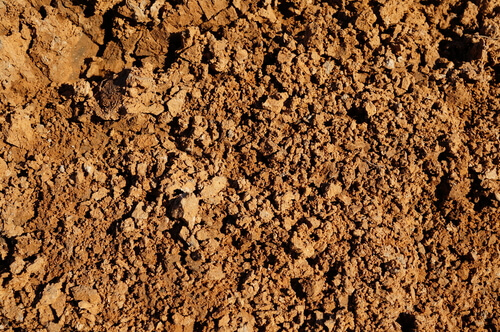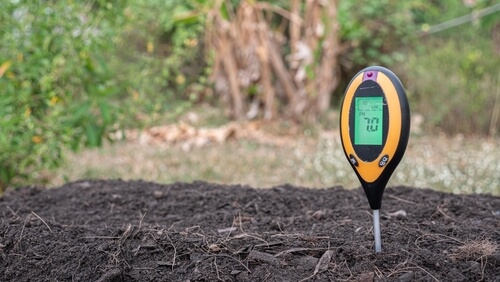Digging Into The Different Types of Soil

When you’re gardening, it’s important to start from the ground up. Before picking out your plants, you first need to understand your soil. Today we’ll explore the different types of soil, recommend the best plants for each, and break down garden soil vs. potting mix vs. top soil. Let’s dig in!
What is Soil?
Soil is a mix of minerals, organic matter from decomposing plants and animals, living organisms, water, and air. Soils are constantly forming all over the world, just very, very slowly. It can take hundreds to thousands of years for just one inch of top soil to be created.
Soil is made by the breakdown of rocks over a long period of time. This weathering can be:
- Physical — collisions, temperature changes, and other weather conditions causing rocks to break down.
- Chemical — minerals in the rock reacting with the environment and affecting their chemical makeup.
- Biological — living things like plant roots and animals causing rocks to crack.
Dirt Vs. Soil
A lot of people use dirt and soil interchangeably, but they are actually quite different. Dirt is made up of natural minerals like clay, sand, and silt, but it doesn’t have the extra components to help plants grow.
Dirt is what your pets track in and what gathers on your children’s clothes after playing outside. By itself, it doesn’t serve a useful purpose in gardening. Soil, however, is a mixture of dirt, organic matter, and other materials—all of which are essential for plants to thrive.
Different Types of Soil Found In Your Garden
As you now know, the foundation of soil is minerals. The main three are clay, sand, and silt. How much of each is present in your soil determines its type and unique characteristics.

Clay Soil
Clay soil is made up of tiny particles that can hold a lot of water and nutrients. This means it drains slowly but can easily handle a drought. Compared to other types of soil for gardening, it doesn’t contain as much air, making it very compact and hard for roots to penetrate.
Plants that like it:
- Daylilies
- Asters
- Lilacs
- Coneflowers
- Hostas
- Most vegetables

Sandy Soil
Considered a light soil, sandy soil has the largest particles and a gritty texture. Because of this, it drains quickly and rain can easily wash out its nutrients. Sandy soil is extremely acidic and easy to work with.
Plants that like it:
- Root vegetables like radishes, beets, and carrots
- Onions and chives
- Thyme, rosemary, and other herbs that grow in Mediterranean climates
- Lavender
- Cacti and succulents
Silty Soil
This fertile soil has medium-sized particles. It’s similar to clay because it retains moisture and is easily compacted, but it doesn’t have the same drainage issues.
Plants that like it:
- Roses
- Perennial grasses
- Butterfly bushes
- Ostrich ferns
- Daffodils
- Lots of trees and shrubs!
Loamy Soil
Of all the different types of soil, loamy is every gardener’s dream! It’s a mix of minerals, allowing it to avoid the extremes of clay and sand. It drains well without drying out, it’s easy to dig in, and it has plenty of nutrients. It’s very fertile and usually the best type of soil for gardening.
Most plants like it! We recommend:
- Tomatoes
- Chili peppers
- Cucumbers
- Strawberries
- Almost any flower
Chalky (Lime-Rich) Soil
This soil can be light or heavy, but it is considered alkaline because it has a high pH. This is due to the presence of calcium carbonate, meaning it won’t support plants that need acidic soil. It’s usually shallow, not fertile, and may also contain lumps of chalky white stone. However, it has excellent drainage because of the bigger particles and rocks!
Plants that like it:
- Yarrows
- Irises
- Carnations
- Kiwis
- Cabbage
- Broccoli
Peaty Soil
Peat is decaying organic matter and it is very fertile. It has a light, spongy texture and it can hold plenty of moisture. It is also acidic, and in many ways, it’s the opposite of chalky soil. Peat is not usually found in gardens and often needs to be amended before use.
Plants that like it:
- Azaleas
- Rhododendrons
- All ericaceous plants
Identifying Your Soil Type
Time to get your hands dirty! There are several ways to test the soil in your backyard, but the easiest is to focus on texture and moisture. Here’s how it works:
- Take a handful of soil and lightly wet it.
- Roll it around in your palm to form a ball.
- Squeeze it lightly and pay attention to how quickly it falls apart.
Clay
- Feels sticky when wet
- Easy to mold in your hands
- Sticks together even when squeezed
Sandy
- Feels gritty
- Won’t hold together when handled
- Crumbles easily
Silty
- Feels silky (like flour) when dry
- Has a soapy, slimy feel when wet
- Holds together at first but breaks apart when handled too much
Loamy
- Feels smooth
- Moist ball sticks together at first but quickly falls apart into clumps when prodded
- Depends on the levels of clay, sand, and silt in your soil
Because of its alkaline nature, a better test for chalky soil is to add a bit of vinegar to your sample. If it froths and fizzes, your soil is alkaline! It may also have noticeable clumps of limestone to tip you off.
For more specifics about your type, learn why pH testing your soil is important.
The Key To Healthy Soil
Now that you know your type of soil and its pH level, you can decide what plants will work best in your garden. You can also consider amending your soil to improve fertility by adding organic matter. We recommend doing this in the fall so it can spend winter decomposing. Most people use:
- Shredded leaves
- Compost
- Peat moss
- Dried animal manure
- Humus
- Mushroom manure or mushroom soil
Garden Soil Vs. Potting Mix Vs. Top Soil
Not all soil is created equally. When talking about different types of soil, you also need to know the difference between potting mix, top soil, and garden soil.
Potting Mix
Potting mix (also known as potting soil) is best for—you guessed it—potted plants! It’s made of a combination of compost or peat moss, bark, perlite, and vermiculite. You know what it doesn’t include? Soil! Potting mix provides nutrients, allows your plant’s roots to expand, and helps water drain from the container.
Potting mix uses: potted plants and starting seeds.
Don’t use it for: outdoor gardens, flower beds, or raised beds.
Top Soil
A lot of people ask, “Is top toil the same as potting soil?” The short answer is no! Top soil is dug up from the top layer of the ground and packaged into a bag. Nothing is added to it, making it the most affordable soil option. However, that also means it doesn’t have as much nutritional value for plant growth.
Top soil uses: filling holes or a base for DIY garden soil.
Don’t use it for: gardening, raised beds, or potted plants.
Garden Soil
Garden soil is top soil that’s been enhanced with organic matter. This provides extra levels of nutrients for your plants. It holds more water than potting mix and is heavier. Because it’s mostly soil, it’s also a lot cheaper than potting mix (and better for spreading around large areas).
Garden soil uses: flower beds or other outdoor gardens.
Don’t use it for: plants in containers.
Premium Soil: Only At Stauffers
Elevate your gardening game with our new premium soils! Packed with nutrients and formulated for optimal growth, our soils ensure your plants receive the care they deserve.
Premium Potting Mix
- Grows healthier potted plants
- Contains slow-release fertilizer
- Blended for success
- Feeds up to nine months
Premium Garden Soil
- Improves soil quality
- Good for vegetables and flowers
- Essential for garden success
- Feeds up to six months
Premium Top Soil
- Spreads easily
- Improves poor soil
- Economically fills low areas and holes
We also pay special attention to our production process. Explore how our premium soils go from the ground to the shelf in this video.
There are many different types of soil, and each has unique characteristics. Now that you have this knowledge, go forth and discover your soil type, amend as needed, and watch your garden thrive!
When it comes to plants, the more you know, the better they grow! Elevate your gardening game and shop our premium soils.





